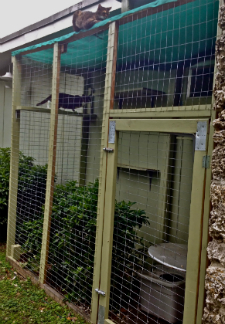Catios 101: Why You Need One and How to Build Your Own Kitty Enclosure
Published on March 15, 2012

As much as I love cats, my son’s asthma is exacerbated by contact with kitties. So we lived without them for 13 years. Luckily, everything changed when I finally broke down and built an outdoor cat enclosure to house two needy adults.
As it turns out, I’m not alone: Cat lovers all over the U.S. are turning to what are known as catios, whether we’re talking about a human health problem or a feline behavior issue. Cat owners are increasingly unwilling to give up on their cats. We’ll do whatever it takes. They’re family, after all.
And when the going gets tough, the tough get crafty. When Tybalt, one of my ex-boyfriend’s cats, couldn’t leave any surface in his home unmarred by his indiscriminate urinating and rehoming him to my third bedroom seemed like the best solution, I had to confront the realities of my son’s asthma . . . creatively.
Then along came Mambrú — a three-legged castaway with severe urinary tract issues — and it seemed that we were destined to see this thing through allergen-free. But there are other reasons why I like the idea of giving cats an outdoor space:
It’s Enriching
Enrichment is an underused term in veterinary medicine. And cats need lots of it. Most of us underestimate our cats’ need to enjoy a variety of interesting activities — even if it’s just staring at birds, watching dogs play in the yard or enjoying the weather. Outdoor enclosures — big or small — are eminently life-enriching.
It Increases Activity
Cats with access to the outdoors move more. They’re less likely to succumb to the fat and lazy downward spiral that afflicts so many felines.
It’s Safe
Catios have always seemed like a great (if imperfect) approach to a very common problem: safety. Cats should ideally stay indoors to stay safe from wildlife, vehicles, other trauma and disease transmission, but some owners just can’t bear to deprive their cats of the great outdoors. Outdoor enclosures are the ideal solution to this dilemma. Plus, it keeps the birds safe too!
But what kind of enclosure to build? There are several types of outdoor cat enclosures, listed here in order from smallest and simplest to largest and most complex:
The Temporary Outdoor Playpen
These are really cool in some cases. Typically made of netting, they can come as tunnels, boxes and teepee shapes, which are easy to set up and bring back inside. The only trouble is that many of them require supervision. I wouldn’t trust one of these tunnels in coyote country, for example, and a sudden rainstorm would make this an uncomfortable experience should you forget that your kitty is outside “enjoying” the weather.
The Simple Window Box
Plenty of kits exist to add an outdoor window box to your casement-style windows. They’re commercially available through multiple sources, but you can also build one yourself.
The Permanent Outdoor Enclosure
These outdoor enclosures — usually built adjacent to the house, with or without access to the indoors — can be purchased from manufacturers who provide prefab screened panels or boxes to create a human-accessible outdoor space.
Alternatively, you can build a simple space using two-by-fours and chicken wire, plus a door for human access (always important in case your cat requires your assistance while in the enclosure).
Catios can offer cool shelves, nooks and crannies, ramps, ladders, dangly toys and other fun accoutrements. A door for indoor access is another fun addition many people love. The best part of this option is that it potentially allows for a completely outdoor litterbox scenario.
The Catio That I Built for My Cats
I decided to utilize my third bedroom, a wasted no-man’s land where knitting supplies have multiplied like rabbits in plastic boxes. This area would serve as an indoor home base. A judicious application of weather stripping on the interior door, and a small perforation in the window for a cat door, served well. Air came in through a vent, and trickled out through the window. Magic. Wasteful magic, AC-wise, but magical nonetheless.
Then came the hard part: designing and building the catio. I had my house’s structure and some existing wood to work with, so I built a 12-foot-wide-by-4-foot-deep enclosure using two-by-fours, chicken wire and water-resistant netting for shade. I connected the third bedroom to the space via a cat door built into a window.
I added some shelves and a bird feeder for my kitties’ viewing pleasure — and voilà — I had a four-star feline home. Tybalt loves hanging out on one of the shelves, and he’s been climbing the shelf habitrail we built on the inside made with lots of staggered Elfa shelving. Mambrú has lost almost four pounds in the eight months since we built the thing. He’s super active now, and is actually quite agile for a three-legged boy.
The litterbox, you ask? I’ve added two of them: One indoors and one out. A week from now, I’m hoping to keep them both outside. I’ve chosen to use disposable boxes, with clumping feline pine for compostability. It’s a little pricier, but hopefully worth the extra expense.
If Tyb starts up with his pee-pee habit again, everything is pretty much plastic in the third bedroom. And if things get really crazy, the cat door has one-way lockability in either direction.
So what do you think? Have you ever thought of doing something like this?
To read more opinion pieces on Vetstreet, click here.





